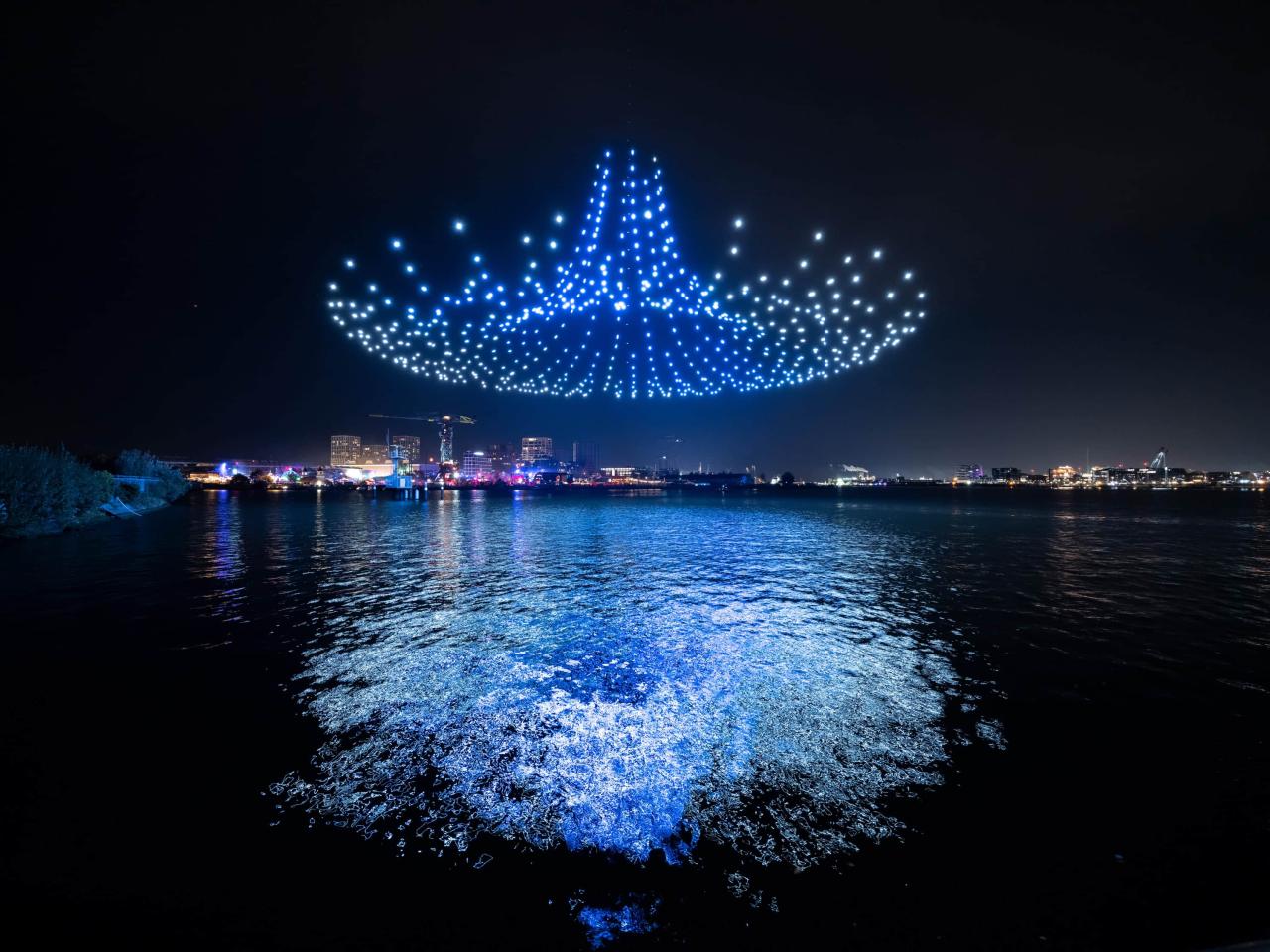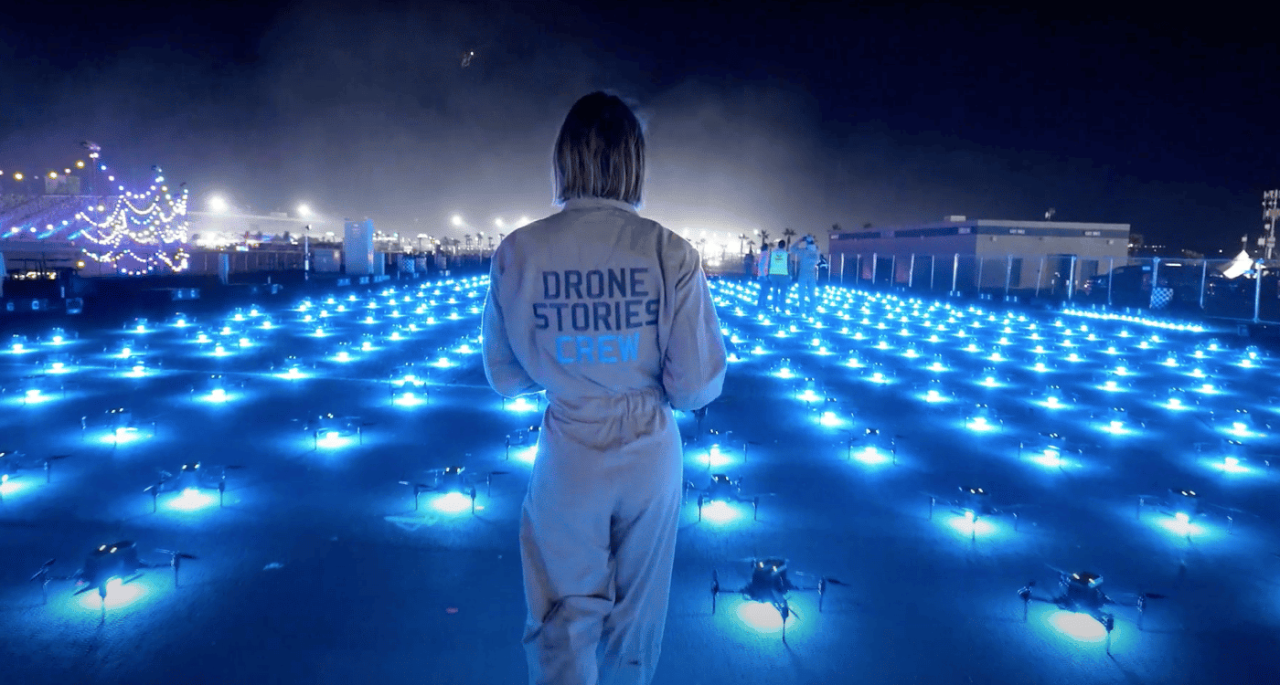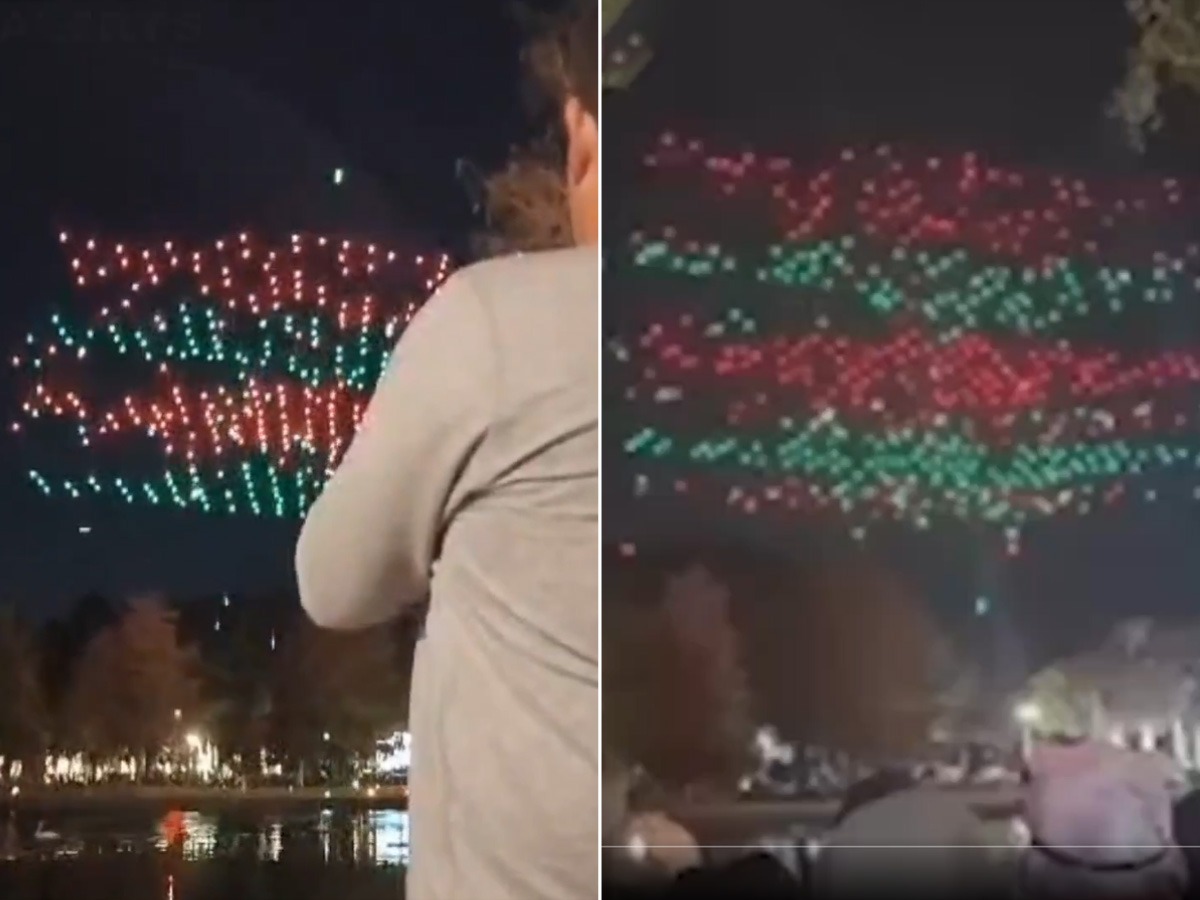Florida Drone Show: This captivating spectacle blends technology and artistry, transforming Florida’s skies into breathtaking canvases. From dazzling light shows choreographed to music to innovative promotional displays, drone shows are rapidly evolving, impacting tourism, entertainment, and the state’s economy. This guide delves into the regulations, locations, types, technology, economic impact, and safety considerations surrounding this exciting phenomenon.
We explore the intricacies of obtaining permits, highlighting the differences between small private events and large public spectacles. We’ll examine popular locations across the state, analyzing their suitability and potential environmental impact. Further, we’ll discuss the diverse types of drone shows, ranging from artistic displays to themed events, highlighting the creative elements and technical expertise involved.
Florida Drone Show Regulations and Permits
Navigating the regulatory landscape for drone shows in Florida requires understanding both state and federal guidelines. This section details the permitting process, focusing on the differences between small, private events and large-scale public spectacles, and provides a county-by-county comparison of permitting requirements.
Permitting Process for Drone Shows in Florida
Securing permits for drone shows in Florida involves a multi-step process. Applicants must first obtain the necessary FAA approvals for commercial drone operations, which includes registering their drones and obtaining a Part 107 Remote Pilot Certificate. State-level permits may also be required depending on the show’s location and scale, potentially involving local municipalities or county authorities. These permits often cover aspects like airspace usage, public safety, and environmental impact.
FAA Regulations for Commercial Drone Operations in Florida
The Federal Aviation Administration (FAA) regulations, particularly Part 107, govern all commercial drone operations, including drone shows. For large-scale shows, additional considerations apply, such as obtaining airspace authorizations from the FAA, implementing robust safety protocols, and ensuring compliance with visual line-of-sight restrictions unless specific waivers are granted. Operators must also adhere to weight limits and operational restrictions specified in the regulations.
Permitting Requirements for Different Types of Drone Shows
Permitting requirements vary significantly based on the scale and nature of the drone show. Small, private events on private property may require fewer permits than large public spectacles in public spaces. Public shows necessitate more extensive permits, involving multiple agencies and detailed safety plans. Factors such as audience size, show duration, and the use of special effects also influence permitting complexities.
Florida drone shows offer spectacular nighttime entertainment, showcasing intricate formations and dazzling light displays. However, the industry also faces challenges, as highlighted by recent incidents like the one detailed in this report on a Florida drone accident , underscoring the importance of safety regulations and pilot training. Ultimately, responsible operation will ensure the continued success and enjoyment of Florida drone shows.
Comparison of Permitting Requirements Across Florida Counties
Permitting requirements can differ substantially across Florida counties. Local ordinances and regulations may add layers of complexity to the permitting process. The table below provides a generalized comparison; it is crucial to check with individual county authorities for precise details.
| County | FAA Requirements | State Permits | Local Permits |
|---|---|---|---|
| Miami-Dade | Part 107 Compliance, Airspace Authorization | Potentially required for large events | Likely required, specific to event location and size |
| Orange | Part 107 Compliance, Airspace Authorization | Potentially required for large events | Likely required, specific to event location and size |
| Broward | Part 107 Compliance, Airspace Authorization | Potentially required for large events | Likely required, specific to event location and size |
| Hillsborough | Part 107 Compliance, Airspace Authorization | Potentially required for large events | Likely required, specific to event location and size |
Popular Florida Drone Show Locations
Several locations in Florida offer ideal settings for drone shows, combining ample open space with convenient amenities and accessibility. This section profiles five popular locations, weighing their advantages and disadvantages for hosting such events.
Five Popular Drone Show Locations in Florida
The selection of a suitable location is paramount for a successful drone show. Factors such as airspace restrictions, proximity to infrastructure, and environmental considerations all play a role. The following table highlights five popular locations, examining their suitability for drone shows.
| Location Name | Suitability Factors | Advantages | Disadvantages |
|---|---|---|---|
| Kennedy Space Center | Vast open space, minimal light pollution, existing infrastructure | Iconic location, ample space, minimal light pollution | Strict security protocols, potential access restrictions |
| Walt Disney World Resort | Controlled environment, existing infrastructure, large audience potential | Large audience capacity, excellent infrastructure, controlled environment | High cost, complex permitting process, potential airspace limitations |
| Daytona Beach | Wide open beach, large viewing area, accessible location | Large viewing area, accessibility, potential for unique visual backdrop | Weather dependent, potential for wind interference |
| Everglades National Park | Vast open space, unique natural setting, minimal light pollution | Unique setting, minimal light pollution, potential for ecological tourism | Environmental regulations, access restrictions, potential for wildlife disturbance |
| Clearwater Beach | Beachfront location, ample space, tourist destination | Attractive setting, large tourist population, accessibility | Potential for wind interference, limited airspace |
Types of Drone Shows in Florida
Drone shows in Florida showcase diverse creative expressions, ranging from themed spectacles to artistic performances and promotional events. This section explores three common types, highlighting their technical and logistical aspects.
Themed Drone Shows
Themed drone shows often center around specific events, holidays, or cultural celebrations. For example, a Fourth of July show might feature patriotic imagery and fireworks-like displays, while a Halloween show could incorporate spooky silhouettes and special effects. These shows require careful choreography to synchronize drone movements with music and other elements.
Artistic Drone Displays
Artistic drone shows prioritize visual aesthetics and creative expression. They might depict abstract art, tell stories through visual narratives, or create dynamic patterns and formations in the sky. These shows often demand advanced programming and choreography skills to achieve intricate and fluid movements.
Promotional Drone Events
Many companies utilize drone shows for promotional purposes, showcasing their brands or products in a visually engaging manner. These shows often involve the integration of company logos, product imagery, and other marketing-related elements into the drone choreography. Logistically, these events require close coordination with marketing teams to ensure effective brand representation.
Technical and Logistical Considerations

Each type of drone show presents unique technical and logistical challenges. Themed shows might require extensive pre-production design and custom-built content. Artistic displays demand advanced programming and choreography, while promotional events necessitate close collaboration with marketing teams. All types require careful consideration of safety protocols, weather conditions, and audience management.
Technological Aspects of Florida Drone Shows
The technology behind Florida’s drone shows is constantly evolving, incorporating innovative hardware, software, and visual effects. This section explores the drones, software, and technologies used to create these spectacular displays.
Types of Drones Used in Florida Drone Shows

Drone shows typically utilize a fleet of small, lightweight drones equipped with bright LEDs. These drones are designed for synchronized flight and precise maneuvers, allowing for complex formations and patterns. The specific models and capabilities vary depending on the show’s requirements, but generally prioritize reliability, flight time, and ease of control.
Software and Hardware for Drone Show Planning and Execution
Sophisticated software plays a crucial role in planning and executing drone shows. Flight planning software allows operators to design intricate choreographies, simulate flight paths, and manage the movements of multiple drones simultaneously. Hardware components include ground control stations, communication systems, and power supplies to manage the drone fleet efficiently.
Florida drone shows are becoming increasingly popular, offering spectacular nighttime displays. However, the recent incident involving an orlando drone show malfunction highlights the potential for technical difficulties. This underscores the importance of rigorous safety protocols and technological advancements to ensure the continued success and safety of future Florida drone shows.
Innovative Technologies Enhancing Visual Effects
Innovations like synchronized lighting effects, GPS-based positioning, and advanced programming techniques are enhancing the visual impact of drone shows. These technologies enable the creation of dynamic and immersive experiences, pushing the boundaries of aerial artistry. For instance, synchronized lighting allows drones to create vibrant, color-changing displays, while GPS positioning ensures precise and coordinated movements.
Flowchart for Planning and Executing a Drone Show

The process of planning and executing a drone show is complex, requiring careful coordination and attention to detail. The flowchart below illustrates the key steps involved.
[A detailed flowchart would be included here, illustrating steps such as concept development, permit acquisition, drone selection, choreography design, rehearsals, and show execution. The flowchart would be visually represented, but since image inclusion is not requested, a textual description is provided instead.]
Economic Impact of Drone Shows in Florida
Drone shows contribute significantly to Florida’s economy, generating revenue, creating jobs, and boosting tourism. This section explores the economic benefits and potential for future growth.
Economic Benefits of Drone Shows
Drone shows attract tourists, generating revenue for hotels, restaurants, and other businesses. They also create jobs for drone operators, programmers, event organizers, and support staff. Furthermore, the shows themselves can generate direct revenue through ticket sales, sponsorships, and merchandise.
Florida drone shows offer spectacular nighttime entertainment, a far cry from the traditional holiday tracking methods. However, for those seeking a different kind of festive tracking, you might consider checking the norad santa tracker phone number for a classic Christmas experience. Then, after that call, you can appreciate the technological advancement of the intricate choreography in a Florida drone show even more.
Potential for Growth and Development
The drone show industry in Florida has considerable potential for growth. As technology advances and the cost of drone technology decreases, more events are likely to be staged. Increased public awareness and the adoption of innovative techniques can further fuel the industry’s expansion.
Support Systems for Drone Show Operators
Several support systems exist to assist drone show operators in Florida. Industry associations provide networking opportunities, training, and advocacy. Funding opportunities may be available through government grants or private investors. These resources help operators navigate the regulatory landscape and access the resources they need to succeed.
Direct and Indirect Economic Effects of a Large-Scale Drone Show
A large-scale drone show in a Florida city can have significant direct and indirect economic effects. These effects are illustrated below:
- Direct Effects: Increased tourism, ticket sales, revenue for event organizers, employment for show staff.
- Indirect Effects: Increased spending at local businesses (hotels, restaurants, shops), increased tax revenue for the city, positive media coverage attracting future events.
Safety and Security Considerations for Florida Drone Shows
Ensuring the safety and security of spectators, infrastructure, and the environment is paramount during drone shows. This section Artikels potential hazards, mitigation strategies, and safety protocols.
Potential Safety Hazards and Mitigation Strategies
Potential hazards include drone malfunctions, loss of control, collisions, and potential risks from falling drones. Mitigation strategies include pre-flight inspections, redundant control systems, emergency landing procedures, and designated safety zones.
Security Protocols for Spectators and Infrastructure

Security protocols may involve crowd control measures, perimeter security, and the use of trained personnel to manage potential risks. These protocols ensure the safety of spectators and prevent unauthorized access to show areas or equipment.
Role of Emergency Response Planning
Emergency response planning is essential to address potential incidents. This involves coordinating with local emergency services, developing contingency plans, and ensuring swift response capabilities in case of unexpected events. Regular drills and training can enhance preparedness.
Sample Safety Checklist for Drone Show Organizers, Florida drone show
A comprehensive safety checklist is vital for ensuring a safe and successful drone show. The following items are crucial:
- Pre-show drone inspections: Verify battery levels, motor functionality, GPS signal strength.
- Flight operation protocols: Adherence to FAA regulations, designated flight zones, communication procedures.
- Emergency procedures: Contingency plans for drone malfunctions, loss of control, weather-related issues.
- Post-show inspections: Account for all drones, review flight logs, assess any damage.
- Spectator safety: Crowd control measures, designated viewing areas, clear communication.
Florida’s drone show landscape is a dynamic and rapidly expanding industry. As technology advances and creative visions expand, the potential for spectacular displays and economic growth remains immense. By understanding the regulations, safety protocols, and economic implications, Florida can continue to foster a thriving and safe drone show industry, ensuring these captivating events remain a source of entertainment and economic benefit for years to come.
This guide serves as a starting point for navigating this exciting and evolving field.
Q&A
What types of drones are typically used in Florida drone shows?
A variety of drones are used, often chosen based on payload capacity, flight time, and lighting capabilities. Common choices include models known for their reliability and ease of synchronization.
How much does it cost to put on a Florida drone show?
Costs vary dramatically depending on the scale, duration, complexity, and number of drones involved. Factors like permits, insurance, and specialized personnel also contribute significantly to the overall expense.
Are there any age restrictions for attending a drone show?
Age restrictions depend on the specific event and venue. Some may be suitable for all ages, while others may have age recommendations or restrictions due to noise levels or other factors. Always check the event’s specific guidelines.
What is the best time of year to attend a Florida drone show?
The ideal time depends on the specific event and location. However, Florida’s pleasant weather makes many times of year suitable, though avoiding peak hurricane season (June-November) is advisable.
